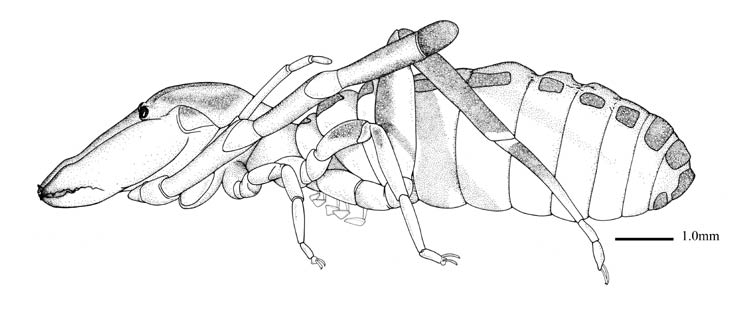| |
- Solifugae (Solpugida)
Common names: sun spiders, camel spiders, wind spiders, solifugids
Probability of
encounter: low
Quarantine importance:
no known importance, but fearsome-looking, aggressive predators that are
sometimes sold as pets (although they tend to be short-lived). Restricted
distributions of some species could be of
conservation concern. Some species are venomous.
Similarity to mites:
none other than general arachnid features. Massive 2-segmented chelicerae
are similar to some endeostigmatid and rhagidiid mites, but mites are much
smaller and lack the clear opisthosomal segmentation of solifugids.
Morphology
Normal adult length:
>1 cm, range 1-10 cm
Body tagmata: prosoma, opisthosoma
Eyes: 2-6 large ocelli
Antennae: absent
Mouthparts: 2-segmented chelicerae; leg-like palps
Legs: 4 pairs, legs I antenniform; legs II-IV ambulatory with divided
trochanters.
Distinguishing features: prosoma with raised plate
(propeltidium) protecting region of large cheliceral muscles and bearing 2-6
often large ocelli, and smaller plates; chelicerae chelate, very
large and hairy; pedipalps leg-like with suckers at their tips for holding
prey (and climbing); coxae and trochanters of legs IV bear 3-5 pairs of
racket organs (malleoli).
Comments: Sexually mature male’s
have backward pointing hook like structures called flagella on their chelicerae
which are used in courtship. The opisthosoma is broadly joined to the prosoma
and has 11 clearly defined segments with distinct tergites and sternites except
where they are fused on the last segment to form a circumanal ring.
Diversity: 12 families, 140 genera, >1075 spp.
References
Harvey, M.S. 2003. Catalogue
of the smaller arachnid orders of the World. CSIRO Publishing,
Collingwood, Victoria
Muma, M.H. 1976. A review of solpugid families with an annotated
list of western hemisphere solpugids. Publications of the Office of
Research, Western New Mexico University, Silver City 2:1-33.
